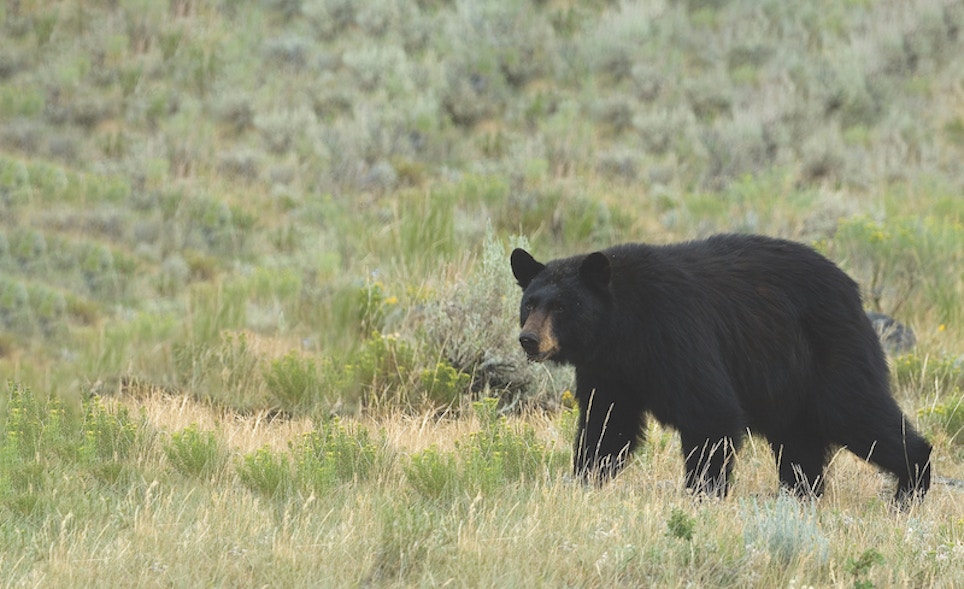
Elk are learning how to cope with black bear predation in the East. Photo: Mississippi Fish and Wildlife Foundation
The elk reintroduction began in 2001, and during those first five to seven springs, bears were slaying calves,” said Joe Yarkovich, elk biologist with Great Smoky Mountains National Park (GSMNP). “Our survival rate one year was 30 percent, and nearly all those calves [killed] were killed by bears.”
Those statistics helped answer why this fledging herd was struggling to maintain its population. Yet no hunting was allowed in GSMNP, so options to reduce black bear predation were limited. Yarkovich got creative, launching a Master’s project in 2006 doing an experimental bear relocation program to increase calf survival. Focusing on the main calving area, biologists trapped and transported 49 bears to other remote areas of the park over the course of three years.
“The first year after the relocation, the survival rate jumped from 30 percent to 85 percent and it stayed that high for the next two years,” Yarkovich said. “After year three, we stopped moving bears and expected survival rates to drop again, but they actually continued to increase.”
The Smokies received its elk from Land Between the Lakes in Kentucky and Elk Island National Park in Alberta, Canada. Neither locale had a robust bear population. However, the GSMNP averages over two black bears per square mile, one of the highest concentrations in the country.
“The elk didn’t know what to do at first when it came to black bears, but what we’ve seen is the recognition, and resulting learned behavior, returning relatively quickly,” Yarkovich said. He points to one female brought from Land Between the Lakes known as Cow No. 15, released into GSMNP’s Cataloochee Valley, the center of the park’s introduction efforts.
“The first year, she calved in an open field, and the calf was killed by a bear,” Yarkovich said. “The next year, she moved just inside the tree line, and the calf was again killed by a bear. The third year she went 6 miles up on a high ridge and had a calf that survived. She continued to calve there and over time her calves started calving up there as well, all with high survival rates.”
Now that cow elk are educated on how best to contend with this bear bonanza, calf survival rates have stayed steady around 80 percent. Bears and vehicles still claim a few, but this herd of more than 250 elk has developed strategies to cope. That’s made Yarkovich’s job a bit more of a rodeo come spring.
“[Cow elk are] actually more defensive, which is bittersweet, because we still try to catch and collar calves, and now we have cows that stand their ground and become aggressive,” he said. “It’s good for the population, but when you’re trying to catch the calf, it can get challenging.”
Elk have had much more time to adapt in another legendary place for huge black bears, 700 miles north in Pennsylvania, where the oldest elk herd east of the Mississippi thrives on the Allegheny Plateau. Jeremy Banfield, Pennsylvania Game Commission elk biologist, says the mix of the Keystone State’s bear hunting tradition and its profusion of whitetail fawns helps keep the elk calf survival rate high.
“[Predation is] surprisingly light compared to other elk herds where black bears are present, particularly those out West,” Banfield said. “The survival studies done on fawns in the elk zone are a little dated now, but we were seeing a 50 percent survival rate of whitetail fawns in the elk zone where calves have a recorded 60 to 80 percent survival rate.”
With an estimated population of 15,500 black bears, Pennsylvania isn’t lacking predators, but the density of those inhabiting the elk zone, .88 bears per mile, is less than half that of the Smokies. Ongoing research in Pennsylvania is still awaiting DNA confirmation to distinguish black bears from coyotes in 90 predation cases, but based on field observations and necropsies, it appears that bears are killing more elk calves than coyotes are. However you slice it, though, predation is the leading cause of mortality. In 2020, bears and coyotes claimed five of 45 collared calves (11 percent), and six of 45 (13 percent) in 2021.
Yet with a calf survival rate of 61 percent in the most recent 2021 survey, and a herd of over 1,400 elk, Banfield doesn’t see black bears as a threat to the health and longevity of the herd.
“I don’t worry about it,” he said. “You have to expect some predation because we have those animals out there, but the predation rate doesn’t limit our population growth.”





